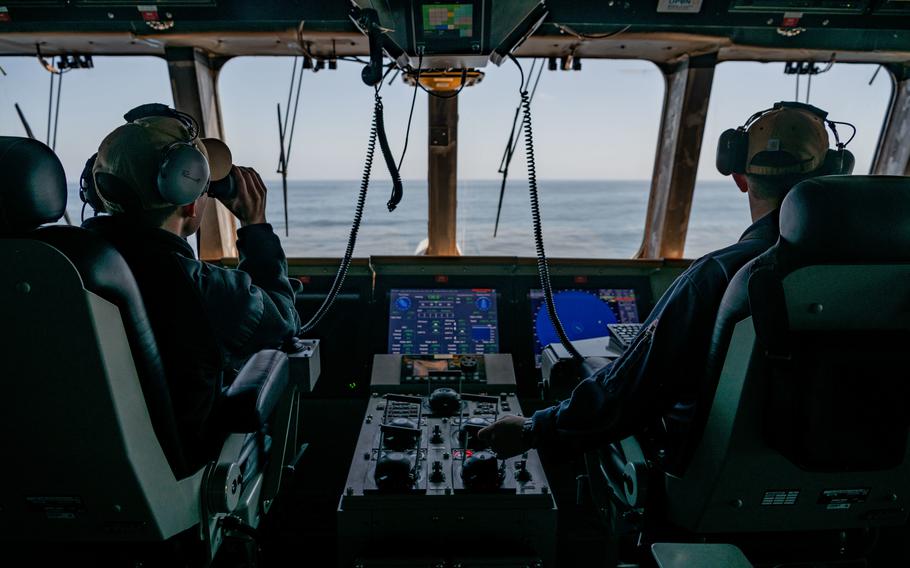
Lt. Austin Gooder, left, and Lt. Cole Roberts stand junior officer and officer of the deck aboard Independence-variant littoral combat ship USS Montgomery during routine underway operations in the eastern Pacific Ocean on April 14, 2022. (Samuel Hardgrove/U.S. Navy)
WASHINGTON — The Navy wants to buy nine warships for its fleet and decommission 11 vessels in its proposed $202.5 billion budget for 2024, the service announced Monday.
The budget request calls for the purchase of two Virginia-class attack submarines, two Arleigh Burke-class destroyers, two Constellation-class frigates, one John Lewis-class oiler and one submarine tender.
It also includes a second Columbia-class, ballistic-missile submarine — a “central component of our recapitalization of our nuclear triad,” said Erik Raven, the undersecretary of the Navy. The triad refers to the three legs of the Defense Department’s nuclear forces: land, air and sea.
The Navy is not requesting any funding for amphibious ships. Of the 11 ships that the service is seeking to cut, there are three Whidbey Island-class dock landing ships, three Ticonderoga-class cruisers and two Independence-class littoral combat ships — the 9-year-old USS Jackson and 8-year-old USS Montgomery. Both ships were expected to have a 25-year service life.
Congress last year allowed the Navy to cut only four of nine littoral combat ships targeted for early retirement. The Navy this year is again asking lawmakers to approve the decommissioning of four ships that the service also wanted retired last year: the guided-missile cruiser USS Vicksburg and dock landing ships USS Germantown, USS Gunston Hall and USS Tortuga.
Raven said the dock landing ships posed a challenge for readiness.
“We want to make sure that the capabilities that we field are the right capabilities,” he said. “We’re proposing those divestments because we think the return on investment on further investments on those particular ships … is not there. Additionally, we have sailors and Marines who are serving on these ships, and we think getting them matched up with the right platforms is the way to go.”
The Navy’s deployable battle force will number 293 ships in fiscal 2024, which begins Oct. 1, compared with 296 now. The service is expected to reach an active-duty end strength of 347,000 sailors and 57,200 Reserve members, an increase of 5,264 sailors and 983 reservists, respectively, from the previous year.
The Navy’s budget request represents a nearly $10 billion, or 5% increase, from last year’s enacted budget. It contains $67.3 billion for operations and maintenance, $63.7 billion for procurement, $42.9 billion for personnel, $23.3 billion for research and development and $5.3 billion for military construction and family housing.
About $17 billion of the procurement request is for 88 aircraft, including fighters, helicopters, unmanned aircraft and training aircraft.
The construction spending plan is a nearly 20% increase compared to last year’s budget and will include the construction of three child development centers, said Rear Adm. John Gumbleton, the deputy assistant secretary of the Navy for budget.
The Navy also wants to boost investment in the Pentagon’s Pacific Deterrence Initiative by nearly 50%, committing $3.2 billion to a “free and open Indo-Pacific” in the face of China’s growing military power. A significant portion of the funds will be spent on construction projects to build up naval bases in Guam, Hawaii and other locations, Gumbleton said.
“We know that our prosperity and security as a nation are dependent upon unfettered access to the sea,” Raven said.